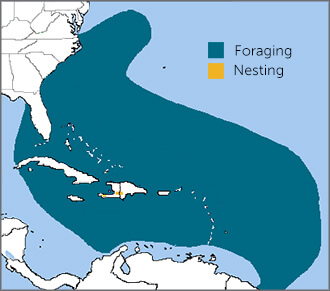
Black-capped Petrel map by ABC.
For years, the long-winged and distinctive Black-capped Petrel was believed to be extinct. Although rediscovered in 1963, this bird remains an enigma. Its genus name Pterodroma derives from the Ancient Greek words pteron, "wing," and dromos, "runner," referring to the quick, weaving flight style of this species and its kin, including the Hawaiian and Galapagos Petrels.
The Black-capped Petrel and its relatives are also known as "gadfly" petrels — another reference to their speedy, erratic flight, which observers thought made the birds look as if they were trying to dodge gadflies (horseflies).
Spooky Nighttime Noises
The Black-capped Petrel's spooky-sounding calls, echoing among its remote mountain breeding grounds at night, earned it the local name Diablotín, or little devil.
Listen to a few of this bird's eerie vocalizations here: https://ebird.org/species/bkcpet
(Audio:© George B. Reynard/Macaulay Library (ML139296))
Caribbean Breeder
The Black-capped Petrel breeds high in the rugged mountains of Hispaniola, the Caribbean island shared by Haiti and the Dominican Republic. It may also nest on other Caribbean islands, including Dominica, Guadeloupe, Cuba, or Jamaica. Like other pelagic species ranging from the majestic Laysan Albatross to the tiny Ringed Storm-Petrel, the majority of this bird's life is spent at sea, ranging over the Caribbean and into the Gulf of Mexico and Atlantic Ocean, from eastern U.S. waters to northeastern Brazil.
There are two variants of the Black-capped Petrel: a dark-faced morph and a light-faced morph. Genetic evidence suggests that these two morphs represent distinct breeding populations, and perhaps even separate subspecies or species.
Undercover Breeding, Oceanic Feeding
Like the Ashy Storm-Petrel, Newell's Shearwater, and many other seabirds, the Black-capped Petrel comes to land only to breed, traveling to and from its nest burrows under the cover of night. It nests high in the mountains, in burrows or rock crevices, often on remote, steep slopes that have been less impacted by deforestation.
Most Black-capped Petrels probably do not breed until they are between five and seven years old, based on what is known of closely related species, such as the Bermuda Petrel (or Cahow). A breeding pair produces a single egg per breeding season, between November and mid-May. This long-lived species may reach 40 years of age.
In keeping with its nocturnal ways, the Black-capped Petrel feeds chiefly at night. It may travel hundreds of miles from its nest burrow to forage over the warm waters of the Gulf Stream, plucking squid, fish, and other sea creatures from the ocean's surface.
Captures for Conservation
The Black-capped Petrel is listed as Endangered by the International Union for Conservation of Nature. It is vulnerable to introduced predators, and habitat loss in known nesting areas is ongoing, including loss from forest fires and encroachment. On land, artificial lights may disorient the birds, leading to collisions with trees, wires, and buildings. At sea, offshore energy development and oil spills may pose additional hazards.
ABC's Marine Program is working with partners to protect the Black-capped Petrel's remaining breeding areas and to minimize threats. In 2014, researchers from ABC partners Grupo Jaragua and the U.S. Geological Survey (USGS) tagged three Black-capped Petrels with lightweight transmitters at a nesting site in the Dominican Republic. Tracking data from this effort expanded our understanding of the species' range at sea, information that is useful in identifying where petrels may be vulnerable to future threats, such as offshore oil and gas drilling or wind turbines.

Black-capped Petrel at sea by Daniel J. Lebbin.
In May 2019, ABC brought together an international team of seabird experts to capture Black-capped Petrels at sea for the first time. The team, composed of USGS scientists, New Zealand experts, and U.S. conservationists, equipped some of these birds with satellite transmitters. Collected data is being used to better understand the species' marine habitat use. This information is of particular interest because offshore wind development is being considered off many parts of the East Coast, perhaps in areas where good numbers of these petrels roam.
The transmitters were also used to track individuals of the light-faced morph, for which nesting grounds remain unknown. (About 100 nests have been found to date, all of the dark-faced morph.) This recent tracking effort followed one light-faced bird back to the Dominican Republic, proving that both morphs occur on the same island.
Protecting the Species
For more than a decade, ABC has been working with partners, primarily Environmental Protection in the Caribbean and Grupo Jaragua, to find, study, and protect Black-capped Petrel nests in Haiti and the Dominican Republic. In late 2021, ABC coauthored an updated Conservation Action Plan summarizing the current knowledge of the species and laying out key actions required to save it.
ABC also continues to urge the United States to sign on to the Agreement on the Conservation of Albatrosses & Petrels (ACAP), which currently includes 13 signatories from France to Uruguay. ACAP works to conserve albatrosses and petrels by coordinating international activities that benefit these birds.
Donate to support ABC's conservation mission!



















































